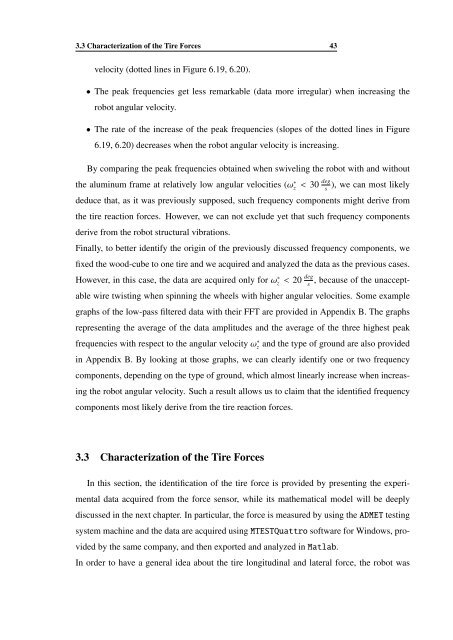Advance Modeling of a Skid-Steering Mobile Robot for Remote ...
Advance Modeling of a Skid-Steering Mobile Robot for Remote ...
Advance Modeling of a Skid-Steering Mobile Robot for Remote ...
- No tags were found...
You also want an ePaper? Increase the reach of your titles
YUMPU automatically turns print PDFs into web optimized ePapers that Google loves.
3.3 Characterization <strong>of</strong> the Tire Forces 43velocity (dotted lines in Figure 6.19, 6.20).• The peak frequencies get less remarkable (data more irregular) when increasing therobot angular velocity.• The rate <strong>of</strong> the increase <strong>of</strong> the peak frequencies (slopes <strong>of</strong> the dotted lines in Figure6.19, 6.20) decreases when the robot angular velocity is increasing.By comparing the peak frequencies obtained when swiveling the robot with and withoutthe aluminum frame at relatively low angular velocities (ω ∗ z< 30 deg ), we can most likelysdeduce that, as it was previously supposed, such frequency components might derive fromthe tire reaction <strong>for</strong>ces. However, we can not exclude yet that such frequency componentsderive from the robot structural vibrations.Finally, to better identify the origin <strong>of</strong> the previously discussed frequency components, wefixed the wood-cube to one tire and we acquired and analyzed the data as the previous cases.However, in this case, the data are acquired only <strong>for</strong> ω ∗ z < 20 deg , because <strong>of</strong> the unaccept-sable wire twisting when spinning the wheels with higher angular velocities. Some examplegraphs <strong>of</strong> the low-pass filtered data with their FFT are provided in Appendix B. The graphsrepresenting the average <strong>of</strong> the data amplitudes and the average <strong>of</strong> the three highest peakfrequencies with respect to the angular velocity ω ∗ z and the type <strong>of</strong> ground are also providedin Appendix B. By looking at those graphs, we can clearly identify one or two frequencycomponents, depending on the type <strong>of</strong> ground, which almost linearly increase when increasingthe robot angular velocity. Such a result allows us to claim that the identified frequencycomponents most likely derive from the tire reaction <strong>for</strong>ces.3.3 Characterization <strong>of</strong> the Tire ForcesIn this section, the identification <strong>of</strong> the tire <strong>for</strong>ce is provided by presenting the experimentaldata acquired from the <strong>for</strong>ce sensor, while its mathematical model will be deeplydiscussed in the next chapter. In particular, the <strong>for</strong>ce is measured by using the ADMET testingsystem machine and the data are acquired using MTESTQuattro s<strong>of</strong>tware <strong>for</strong> Windows, providedby the same company, and then exported and analyzed in Matlab.In order to have a general idea about the tire longitudinal and lateral <strong>for</strong>ce, the robot was
















